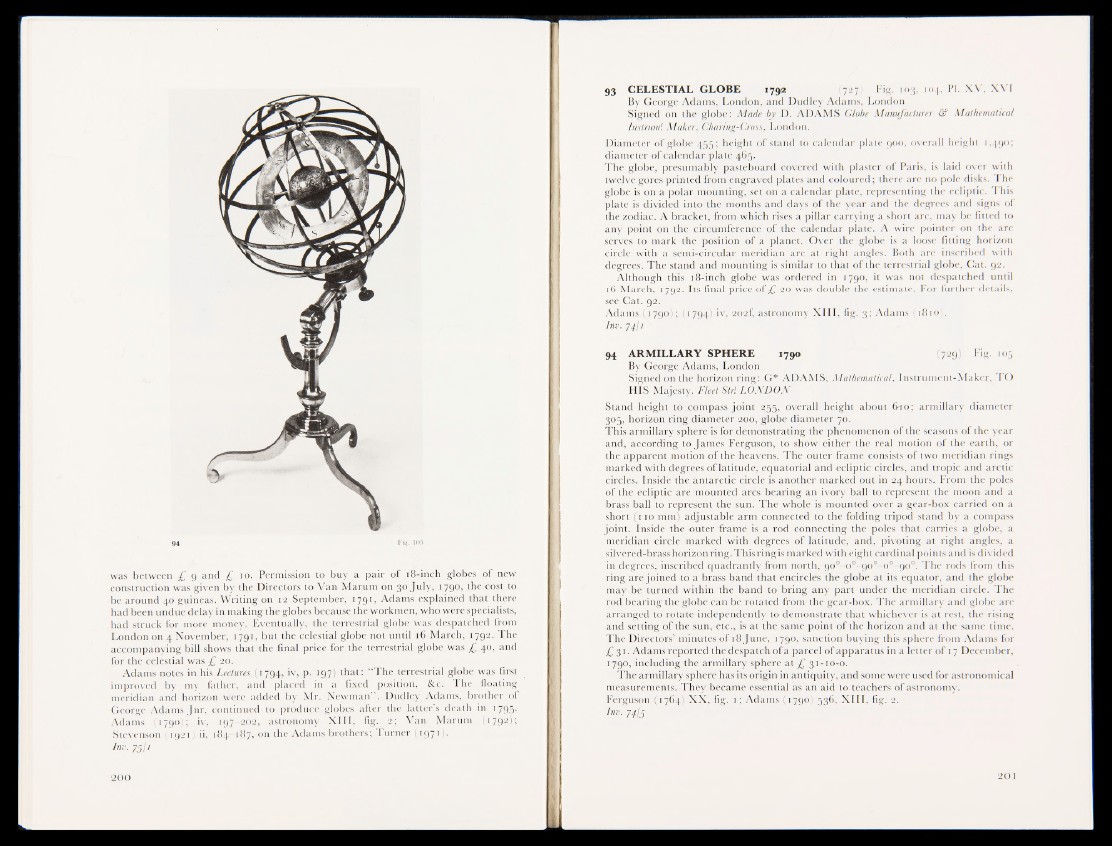
94 F i g ' B H
was between £ 9 and £ 10. Permission to buy a pair of 18-inch globes of new
construction was given by the Directors to Van Marum on 30 July, 1790, the cost to
be around 40 guineas. Writing on 12 September, 1791, Adams explained that there
had been undue delay in making the globes because the workmen, who were specialists,
had struck for more money. Eventually, the terrestrial globe was despatched from
London on 4 November, 1791, but the celestial globe not until 16 March, 1792. The
accompanying bill shows that the final price for the terrestrial globe was £ 40, and
for the celestial was £ 20.
Adams notes in his Lectures (1794, iv, p. 197) that: “ The terrestrial globe was first
improved by my father, and placed in a fixed position, &c. The floating
meridian and horizon were added by Mr. Newman” . Dudley Adams, brother of
George Adams Jnr, continued to produce globes after the latter’s death in 1795-
Adams (1790); iv, 197—202, astronomy XIII, fig. 2; Van Marum (1792);
Stevenson (1921) ii, 184-187*00 the Adams brothers; Turner,J1971).
Inv. Bffl
93 CELESTIAL GLOBE 1792 (727) Fig. 103, 104, PI. XV, XVI
By George Adams, London, and Dudley Adams, London
Signed on the globe: Made by D. ADAMS Globe Manufacturer & Mathematical
Instrum1. Maker, Charing-Cross, London.
Diameter of globe 455; height of stand to calendar plate 900, overall height 1,490;
diameter of calendar plate 465.
The globe, presumably pasteboard covered with plaster of Paris, is laid over with
twelve gores printed from engraved plates and coloured; there are no pole disks. The
globe is on a polar mounting, set on a calendar plate, representing the ecliptic. This
plate is divided into the months and days of the year and the degrees and signs of
the zodiac. A bracket, from which rises a pillar carrying a short arc, may be fitted to
any point on the circumference of the calendar plate. A wire pointer on the arc
serves to mark the position of a planet. Over the globe is a loose fitting horizon
circle with a semi-circular meridian arc at right angles. Both are inscribed with
degrees. The stand and mounting is similar to that of the terrestrial globe, Cat. 92.
Although this 18-inch globe was ordered in 1790, it was not despatched until
16 March, 1792. Its final price of/) 20 was double the estimate. For further details,
see Gat. P
Ad a ms (1 790)^ 1794) iv, 202f, astronomy XIII, fig. 3; Adams (1810).
Inv. 74/1 1
94 ARMILLARY SPHERE 1790 (729) Fig. 105
By George Adams, London
Signed on the horizon ring: G* ADAMS, Mathematical, Instrument-Maker, TO
HIS Majesty. Fleet Str! LONDON
Stand height to compass joint 255, overall height about 6ro; armillary diameter
305, horizon ring diameter 200, globe diameter 70.
This armillary sphere is for demonstrating the phenomenon of the seasons of the year
and, according to James Ferguson, to show either the real motion of the earth, or
the apparent motion of the heavens. The outer frame consists of two meridian rings
marked with degrees of latitude, equatorial and ecliptic circles, and tropic and arctic
circles. Inside the antarctic circle is another marked out in 24 hours. From the poles
of the ecliptic are mounted arcs bearing an ivory ball to represent the moon and a
brass ball to represent the sun. The whole is mounted over a gear-box carried on a
short |ji 10 mm) adjustable arm connected to the folding tripod stand by a compass
joint. Inside the outer frame is a rod connecting the poles that carries a globe, a
meridian circle marked with degrees of latitude, and, pivoting at right angles, a
silvered-brass horizSS&ing. This ring is marked with eight cardinal points and is divided
in degrees, inscribed quadrantly from north, go°-o0^90°—o°—90°. The rods from this
ring are joined to a brass band that encircles the globe at its equator, and the globe
may be turned within the band to bring any part under the meridian circle. The
rod bearing the globe can be rotated from the gear-box. The armillary and globe are
arranged to rotate independently to demonstrate that whichever is at rest, the rising
and setting of the sun, etc., is at the same point of the horizon and at the same time.
The Directors’ minutes of 18 June, 1790, sanction buying this sphere from Adams for
£31. Adams reported the despatch of a parcel of apparatus in a letter of 17 December,
1790, including the armillary sphere at £ 31-10-0.
The armillary sphere has its origin in antiquity, and some were used for astronomical
measurements. They became essential as an aid to teachers of astronomy.
Ferguson (1764) XX, fig. 1; Adams (1790) 536, XIII, fig. 2.
Inv. 7 f 5